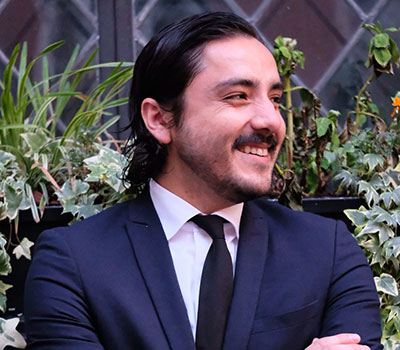

A native of Santiago, Chile, Juan Pablo Escobar worked at Manzo Ristorante (Eataly-Flatiron), Lupa Osteria Romana and Otto Enoteca e Pizzeria before landing at Babbo in 2015. He took over as wine director in 2019 and now manages the 80-page, all-Italian (except for Champagne) wine list as well as the bar program. Babbo’s more than 150 selections of Chianti Classico, organized by village, represent one of the deepest and most comprehensive lists we’ve seen from this region.
Has the size or composition of your wine team changed this year?
Absolutely. Before we closed [in 2020], we had a full team, including a cellar organizer, and we were able to hire people who really knew their wines. When I came back from the pandemic, I was alone for first few months. The first guy I hired was someone I knew; he had been in the business and had some experience. But after that, we had to go with people who maybe had less experience but had the right attitude, were willing to learn, and then I work on teaching them. My idea is to hire people who want to work here and learn, and just grow them.
How has pandemic dining changed your buying?
We still have a lot of wine—we were not missing out on our allocations because we want to maintain verticals and put some away. I always like to pour wines BTG that are not necessarily well known, sometimes grapes nobody has heard of, but they are balanced and pure. I usually blind-taste guests on them so they’re not judging based on a name or a region, and I ask them to compare to other wines they have tried. For example, I’ve poured a raboso, a vermentino nero from Colli di Luni, and a roviello bianco from Campania. I’m not afraid to do that. I could just put a barbera on there and sell tons of quartinos, but that’s not what we want to do. We have the 2013 Canadialle Chianti Classico from Panzano, it’s showing really well right now. I try to keep a balance from north to south. We might try to pour northern whites during winter, then in summer go to Sicliy or Sardinia.
How have your interactions with guests changed this year, with regard to discussions about the wine list?
Anything can happen here. We can have a guest coming in for an early dinner at the bar, and they end up ordering $10-15,000 of wine made by one of their ancestors. It opens up a whole conversion. For us, to be passionate and have the time to talk about what we love is important.
Also, when people just trust us to choose for them, and they have an experience and becomes a memorable evening for them and they tell you….that is a nice thing.
Has your cocktail list changed at all?
I’m also in charge of the bar and have tried to work on a cocktail list that uses Italian ingredients and that will draw in the younger crowd. We also have lots of amaro and grappa selections.
Your Chianti Classico list is the most comprehensive I’ve seen in this country, and it’s organized by village—something people have been doing with Barolo for a while, but not so much with Chianti Classico. In fact, you’ve even divided some of the villages into smaller units (Panzano, Lamole and Montefioralle in Greve, which are now separate UGAs as of last summer). How did this come about?
Jeff Porter and Michael Acheson started the whole thing, buying Chianti Classico verticals [going back to around 2010]. For example, we have [Radda producer] Pruneto’s 2010, ‘11, ‘12 and ‘13, so you can enjoy four different vintages of that wine for under $80 a bottle because of their foresight. Me and Evan [Clagnaz] changed the organization of the list, and it’s been like this since 2018. I went to Chianti Classico in 2019, learning more about it, the political borders but also the geological and soil and temperature differences. That’s when I started getting into smaller zones, dividing Greve for example into more units. I’ve always found a lot of contrast in the wines, and that’s why I’ve been grouping it that way.
It’s actually easier for us to talk about, because it’s such an extensive wine list. We can ask certain questions, like are you looking for graceful and elegant? Something more powerful? That allows us to go to a specific subzone and make the connection between soil, microclimate and elevation. It also elevates the denomination [of Chianti Classico]. I love nebbiolo for example, but it is harder to afford. I’ve found myself drinking more and more sangiovese.
Does this organization change your buying strategy at all? For example, do you buy Chianti Classico Annatas that are made with fruit from multiple villages?
I’ve always liked to put the current release Annatas on the list and maybe pour BTG. We try to showcase what we believe Chianti Classico is. It’s an overlooked region and there is tremendous value in the wine; the farming practices are better than in many other parts of Italy—about half are organic. I definitely don’t buy wines from bottlers [companies that buy wine from multiple sources and bottle it, often in massive quantities]. Those wines are kind of neutral, they don’t show the personalities of Chianti Classico.
What’s been the reaction of guests to that amount of dissection and information? How do you talk about the differences from one place to another?
It’s what we do, we have all these toys to play with, it is kind of like a teaching opportunity. Lots of people who come here want to have a special experience; it may be a vintage they’re looking for, or a wine from a specific place, and we want to have the tools to give them the best option. We try to read the table, we want to be discreet, but we usually just give a few options of wines with some primary characteristics. Sometimes they’ll give you a budget, or say we’re eating this and want to spend x, we trust you. I just try then to pick something and give them a little information to make it more special for them. Being a beverage director, I had to learn that the most important people are the guests and the producers; I need to make that link, try to match those two interests up in a way that will work for both. It’s a very large list, 80 pages long, and the last thing I want is to give the guest a headache.
is the Italian wine editor at Wine & Spirits magazine.
This is a W&S web exclusive. Get access to all of our feature stories by signing up today.




















